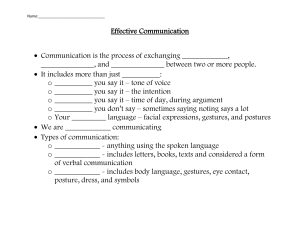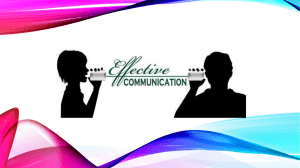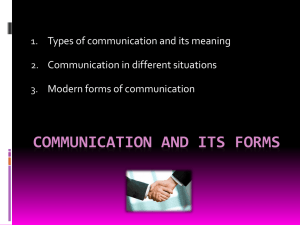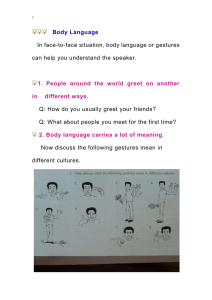Non-Verbal Communication in University Presentations
advertisement
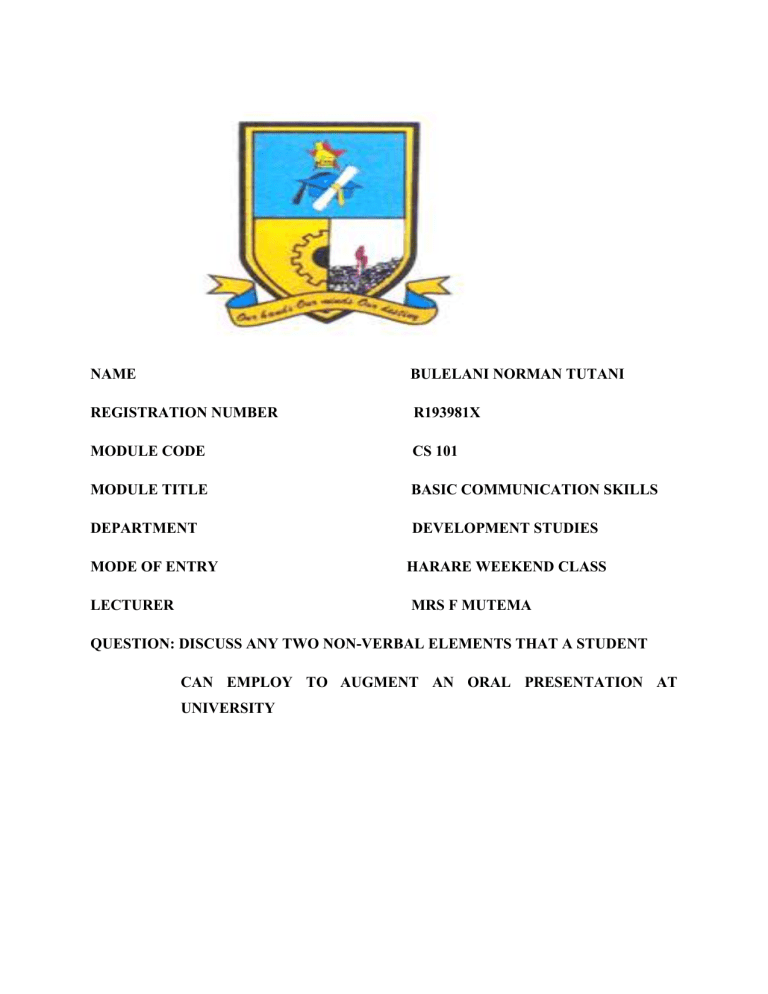
NAME BULELANI NORMAN TUTANI REGISTRATION NUMBER R193981X MODULE CODE CS 101 MODULE TITLE BASIC COMMUNICATION SKILLS DEPARTMENT DEVELOPMENT STUDIES MODE OF ENTRY LECTURER HARARE WEEKEND CLASS MRS F MUTEMA QUESTION: DISCUSS ANY TWO NON-VERBAL ELEMENTS THAT A STUDENT CAN EMPLOY TO AUGMENT AN ORAL PRESENTATION AT UNIVERSITY There are non-verbal elements that one can use to put more emphasis on an oral presentation, elements that are easy for people to understand. They are a lot of these non-verbal communication but will discuss the two that is Eye contact and Gesture. Definition of terms Non-verbal is the transmission of messages or signals through a non-verbal platform. Eye contact is communicating through looking at each other’s eyes. Gesture is a movement of a part of a body especially a hand or head to express an idea or meaning. Borg (2004) states that "in a face-to-face encounter 93 percent of the impact of your message is non-verbal while 7 percent of the impact of your message is verbal.” and according to Reece and Brandt (2006) they say that most of the non-verbal messages can be said to be sent through eyes. In addition to that Fast (1970:143) reports Jose' Ortega Gasset's metaphor for the human look as follows: "He felt that the eye, with its lids and socket, its iris and pupil was equivalent to a whole theatre with its stage and actors" so having eye contact on your presentation can be a movie that people will be watching as you present. Moreover (Borg, 2004:59; the present author's emphases) says lack of eye contact behavior can give the addressee (s) an impression that one is "talking at people instead of to them" therefore employing that eye contact in communication is very crucial on the part of presenters. last but not least eye contact builds bond between people, so it is helpful if you are trying to get someone to focus on what you have to say (Sonneborn 2011:23). On another hand according to (Sonneborn 2011:25 “too much eye contact is just as bad as too little because too little will make you appear uninterested in the other person, while too much will make you seem angry and aggressive.” also he alludes to the point that if you don’t make that early eye contact you run the risk of losing people's attention for the entire presentation Sonneborn (2011). Gestures are a specific bodily movement that reinforce a verbal message or conveys a particular thought or emotion. Seth (2010:219) says "gestures compliment your verbal presentation" and he also continues to mention types of gestures as: Emphatic gestures are used to emphasize or lay stress on a word that is important in your massage. Descriptive gestures are used to provide a visualization effect for your message. For example, if you are talking of something big, you open your arms wide. Transitional gestures may be used to list out or enumerate things, for example counting on your fingers to enumerate the three types of negotiating approaches. Moreover, gesture is a specific bodily movement that reinforce a verbal message or conveys a particular thought or emotion. Calbris (2011) also alludes to the point that “when gestures accompany speech, it assumes specific functions in relation to what is being said” while Aquino ed (2008) says gestures may clarify or intensify the meaning of an utterances, meaning to say a student can be helped in putting his point across by the use of gestures. Last but not least gestures strengthen the audience’s understanding of your verbal message, they also help point vivid pictures in your listener’s minds. However, we see that when gestures are not employed tactfully and skillfully can spell disaster to a student. Sethi (2010) points out that if you overdo gestures they can be annoying or distracting, also using the same gestures can be boring, while Aquino lastly says gestures is “cultural-bound” meaning not all gestures convey a universal meaning. In closing we have seen that for a student to make a good and appealing oral presentation he/she should employ non-verbal cues to augment it, and the two that we have seen is eye contact and gestures. If these two are given justice, they do make an oral presentation powerful and we have seen the other side of the coin that if not done diligently one cannot protrude the intended message to the audience. REFERENCES Aquino A 2008, speech and oral communication for nursing, ed. Rex bookstore, Inc. 166 Calbris G, elements of meaning in gesture, john Benjamins publishing company Amsterdam Sonnerborn L,2011. non-verbal communication, the art of body language. The Rosen publishing group Sethi,2010. business communication, Tata, McGraw-Hill education Steven, G. McCafferty, Gale stam,2009. Gesture, Routledge, New York www.researchgate.net/publication/2759656339 22/08/2019
